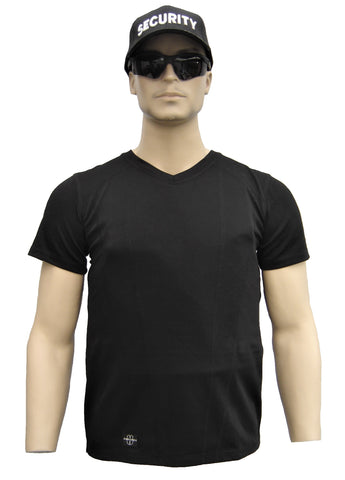Reload data 30 Super Carry and 7.92x24mm comparison
Reload data 30 Super Carry and 7.92x24mm comparison. Effect of high chamber pressure vs high case capacity. Reloading dies load .312 Hornady XTP (85 grains). Body armor to stop these bullets.
Introduction
The nomination of the new .30 pistol (PDW) calibers.

Both calibers 30 Super Carry and 7.92x24mm using basical the same .32 caliber bullets. The .32 caliber is for most people in the United States relate to the .32 ACP cartridge and in Europe to the 7.65 Browning cartridge. Althrough the 7.65 Browning was a revolutionair cartridge at his time and was used in many old military pistols, according to modern standards the .32 ACP caliber is generaly conciderd as underpowerd and too weak for personal defence. To prevent a negative association with the underpowered .32 ACP / 7.65 Browning cardridge, the designers opt for a different nomination.
In Europe, to prevent the association with the 7,65 Browing, VBR-Belgium did choose the efective diameter of the .312 bullet with is 7.92mm and according to the metric system did nominate the caliber 7.92x24mm (2).
In the United States, to prevent the association with the .32 ACP cartride, Federal Premium Ammunition did choose for the barrel nomination as a .30 barrel and his target audience the .30 Super Carry (3).
The positioning of the 30 Super Carry and the 7.92x24mm

1) 9x19mm NATO cartridge
2) 7.92x24mm (S) Short cartridge
3) .30 Super Carry cartridge
4) 7.92x24 mm (N) Normal cartridge
5) .45 ACP cartridge
While the 30 Super Carry (3) is intend to use in the 9x19mm (1) frame platforms. The 7.92x24mm N (4) was intend for the .45 ACP (5) frame platforms. Only the 7.92x24mm caliber was designed from the beginning to function in an interchangeable multi caliber roll in both 9x19 en 45 ACP frames by giving the bullet a deeper seating depth which resulted in the 7.92x24mm S (2) cartridge.
Reloading data comparison

At this moment there are little to non data available about the performance of specific loads out certain pistols and specific barrel length with the 7.92x24mm and 30 Super Carry. However, regarding the available data, certain conclusions can already be made. Warning, reloading near maximum allowed pressure , unknown tolerances may cause dangerous overpressure!
Different maximum allowed chamber pressures!
The maximum allowed chamber pressure for the 30 Super Carry is 52.000 psi. This is in the line of the caliber 5.7x28mm (50.038 psi).
The maximum allowed C.I.P. chamber pressure for the 7.92x24mm is 46.412 psi. Since the 7.92x24mm case is a shortened .30 carbine case the same maximum CIP allowed chamber pressure as the .30 carbine was chosen (46.410 psi). This is already a lot more then what the 9x19mm (34.084 psi) allows and in a multi caliber roll, not all pistols have the same strong construction behind the breech face. At this moment there is no technical information about 7.92x24mm+P loads or the military loads who are not bounded by the C.I.P. specifications.
The 1911 pistol frame platform.

The reloading data and shooting performance are both based on a 1911 pistol which has the same strong construction. For the 30 Supper Carry these performances are achieved with a Nighthawk Custom 1911 with 5” barrel and for the 7.92x24 mm N these performances are achieved with a PSW Multi caliber 1911 with a 4” barrel. This is not exactly the same but it gives an impression of the velocity regarding to the chamber pressure.
Same bullet Hornady XTP (85 grains)
Since the 7.92x24mm N and the 30 Super Carry can use the same Hornady XTP (85 grains) bullets, this proves how close they are related to each other.
Sorce:
Handloader TV / .30 Super Carry Handloads - Nighthawk Custom 1911
https://www.youtube.com/watch?v=5cY6NyV-EWM
Data:
Nighthawk Custom 1911 with 5” barrel
Cal. .30 Supper Carry
Bullet: .312 Hornady XTP (85 grains)
Powder: Accurate No. 5 (5.7 grains)
Primer: CCI 500
Brass: Federal (once fired)
Maximum average Pressure allowed 52.000 psi
COAL: 1.085” (27.55 mm)
Average velocity: 1317 fps - 401 m/s
Sorce:
VBR-Belgium reloading data
Data:
PSW Multicaliber 1911 with 4” barrel (Commander)
Cal. 7.92x24mm N (Normal) VBR-B
Bullet: .312 Hornady XTP (85 grains)
Powder: Vihtavuori N320 (5.4 grains)
Primer: CCI 500
Brass: Remington-Peters .30 Carbine shortened to 24mm
Maximum average Pressure allowed 46.412 psi
COAL: 1.264” (32.11 mm)
Average velocity: 1379 fps - 420 m/s
Comparison
With the same .312 Hornady XTP (85 grains) bullet and despites the higher chamber pressure (52.000 psi) of the 30 Super Carry and the longer 5” barrel, the 7.92x24mm N cartridge with a lower chamber pressure (46.412psi) and only a 4” barrel achieve even a 1379 - 1317= 62 fps higher velocity.
Although difference in propellant can cause differences in velocity this comparison proofs that the 30 Super Carry performances are almost identical to the 7.92x24mm N VBR-B cartridge.
High Chamber Pressure vs Useable Case Capacity.
With the same length of the .312 Hornady XTP (85 grains) bullet, the short overall length (1.085”/27.55 mm) limits the Useable Case Capacity of the 30 Super Carry by which fast high pressures occur. The 7.92x24mm N has a longer overall length (1.264”/32.11 mm) and has a significant bigger Useable Case Capacity left which reduces the peek pressure in the chamber but ignite a larger amount of propellant which results in a higher velocity.
Nighthawk Custom 1911 with 5” barrel in 30 Super Carry
The Nighthawk Custom 1911 with 5” barrel may be a fantastic pistol but the short 30 Super Carry is underpowered compared to the 7.92x24mm N caliber to be used in a full size 1911 frame pistol. If the .30 barrel should have been installed in a full size 1911 - 45 Nighthawk Custom frame, the performances should be even better and the pistol should have more punch to flipover the steel targets.
Interesting gadgets
Chamber reamers for the 7.92x24mm

Reloading dies 7.92x24mm

Level of body armor needed to stop a 7.92x24mm or 30 Super Carry bullet
Since the calibers 7.92x24mm and 30 Super Carry using the same type of bullets at similar velocities it is to expect they have the same behavior at soft body armor. .

Although, there is not jet official NIJ certified body armor against the 7.92x24mm and 30 Super Carry cartridges, the energy level is at the level of the 7.62x25mm Tokarev. Although not all NIJ-3A body armor can stop the 7.62x25mm Tokarev at a safe way, we can say that all bullet proof vests who are certified against the 7.62x25mm Tokarev are the most suited to stop the bullets out the 7.92x24mm and 30 Super Carry pistols.
Light weight .312 full metal jacket bullets are composed with a soft lead core that can be stopped by the most type of level NIJ-3A + 7.62x25mm Tokarev body armor.
Hollow point bullets are forbidden by law in the most European countries, where they are allowed as in the United States, the weaker hollow point tip expands fast at impact which reduces the drill performance. Also most type of level NIJ-3A + 7.62x25mm Tokarev body armor can stop 7.92x24mm and 30 Super Carry hollow point bullets.

Casted copper plated bullets are significant cheaper but to withstand the high velocity these type of .312 bullets need to be casted with a hard lead alloy. These bullets deform less and penetrate deeper at soft body armor. A level NIJ-3A + 7.62x25mm Tokarev is the absolute minimum.
Engarde® FLEX-PRO™ bullet proof vests

Engarde® Deluxe FLEX-PRO™ concealed bullet proof vests

Deluxe FLEX-PRO black bullet proof vest
Deluxe FLEX-PRO white bullet proof vest

Engarde® T-shirt FLEX-PRO™ concealed bullet proof vests

T-shirt FLEX-PRO black bullet proof vest
.
Visitors from the USA interested in body armor please visit Engarde USA
